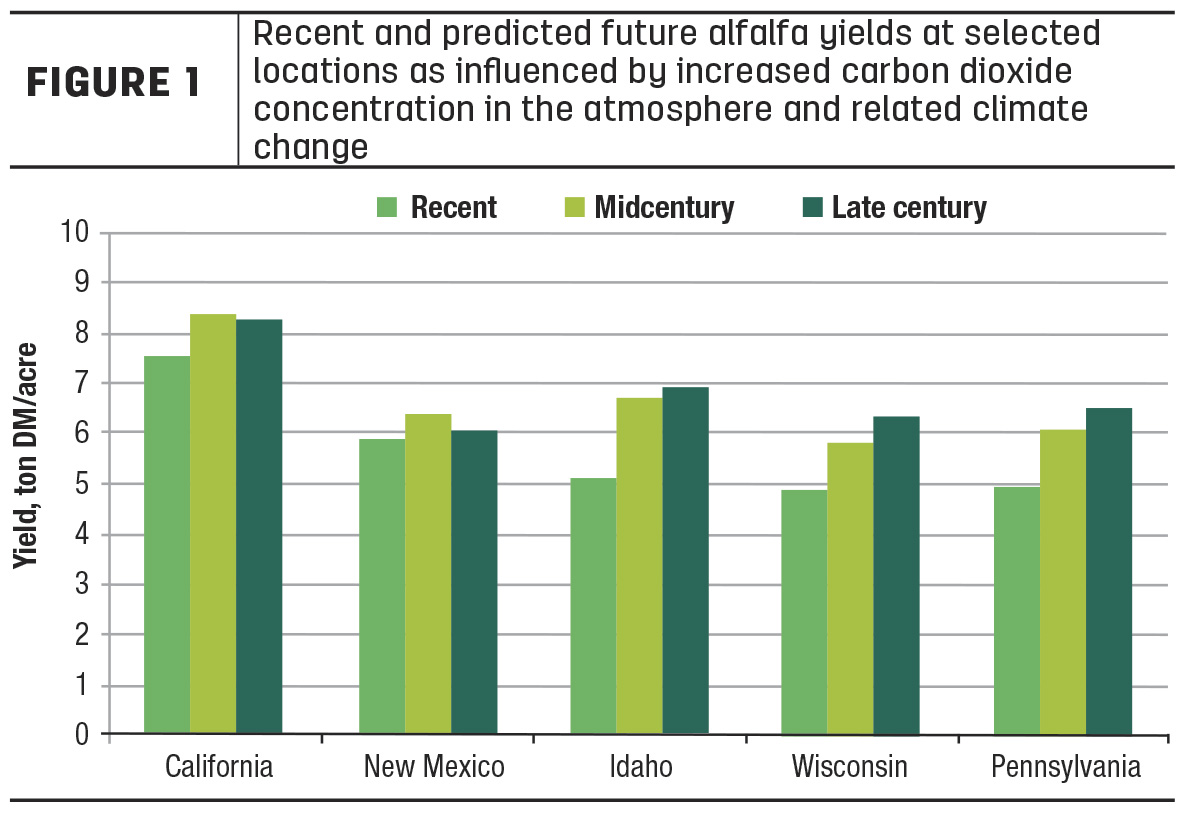Climate change has become an important social issue. We know much about the science surrounding climate change, but science is often ignored by both those promoting and denying the issue. Let’s look at the scientific evidence and potential effects of climate change on forage production. We will consider historical changes, what is likely to occur in the future and how that may affect forage production. By preparing for the future, steps can be taken to adapt to the change, providing a productive and sustainable future for alfalfa and other forage crops.
Our changing climate
Changes in climate are slow and difficult to observe over time. Weather varies considerably from day to day and year to year, masking the change that is occurring. Only through long-term measurements can we quantify changes in temperature and precipitation. Temperature measurements across the U.S. since 1991 have documented a 1oF to 2oF increase in average annual temperature in Northern and Western regions with little change in much of the Southeast. Measures of average global temperature have shown about a 1oF increase over this 30-year period and almost a 2oF increase since 1900. This may not seem like much change, but this is substantial over this relatively short period in the earth’s history.
Precipitation patterns are also changing, but the magnitude and direction of change varies greatly among locations. In general, drier regions are getting drier and wetter regions are getting wetter. For much of the western U.S., there has been minor change in long-term annual precipitation over the past century. Some local regions have seen 0%-10% increases, while others have seen 10% decreases. The driest region is Southern California and Arizona where much of this region has seen 10%-20% decreases in annual precipitation. Much of the Midwest and Northeast have experienced 10%-20% increases in precipitation. This increase has occurred primarily through more intense storms. Extreme rainfall events have increased by about 40% in the northern U.S. over the past century with little change in the Southwestern states.
A challenge in Western states is a decrease in winter snowpack in the mountains. With increasing temperature and changes in precipitation, less snow is accumulating, and thus, less is available through summer snowmelt. This is of particular concern for those that rely on this water source for crop irrigation.
These changes are well documented, but the cause is often questioned. Scientific evidence strongly supports that the cause is increasing carbon dioxide (CO2) concentrations in the atmosphere. Measurements have documented about a 30% increase in this concentration since 1960. Measurements made through ice bores in the Antarctic indicate that current levels far exceed anything that has occurred throughout human history. There is a high correlation between global temperature and atmospheric CO2 concentration.
Carbon dioxide and some other gases in the atmosphere, including methane (CH4), trap heat radiated from the sun. This is a good thing because without this heat-trapping blanket around our planet, temperatures would be too cold for us to survive. The problem is that these increasing gas concentrations are thickening the blanket and causing temperatures to rise. The primary cause of this increase in concentrations is the burning of fossil fuels. For each gallon of fuel consumed, about 20 pounds of CO2 are created and emitted to the atmosphere. This is taking carbon that had been stored in the earth for many thousands of years and adding new CO2 to the atmosphere much more rapidly than it can be absorbed into vegetation, soil and ocean water.
Methane from cattle also receives much attention as a cause of global warming. Cattle produce a lot of methane (which has more warming potential than CO2), but this is part of a natural cycle that has been happening for many years. Methane from cattle oxidizes in the atmosphere, transforming carbon back to CO2. Since this carbon originally came from CO2 in the atmosphere through fixation by feed crops, this completes a natural cycle. Therefore, methane emission from cattle has a strong short-term impact but does not create a long-term accumulation in the atmosphere such as we are experiencing from the CO2 created through fossil fuel use.
Our future climate
To look into the future, we must rely on models. Many global climate models have been developed throughout the world. These models use mathematics to represent the complex physical, biological and chemical relationships and interactions between the land, ocean and atmospheric processes that drive our weather and climate. These models are becoming more sophisticated and accurate in their predictions.
We have selected nine of these models to study future climate and daily weather patterns for regions of the U.S. throughout the rest of this century. A worst-case scenario was modeled where the international consumption of fossil fuels continues at its current rate. Predicted weather data were summarized for recent (1996-2015), mid-century (2040-59) and late-century (2081-2100) periods.
Based upon the current rate of greenhouse gas emissions, average annual temperatures are predicted to increase by 3oF to 4oF by mid-century and 8oF to 10oF by the end of the century. Similar increases in temperature are generally predicted for all seasons of the year. Temperature increases tend to be a little greater in more Northern locations relative to Southern locations.
These predictions assume little is done to reduce our current CO2 emission rates. Steps are being taken though to reduce fossil fuel use and related emissions. Therefore, temperature increases may begin to slow by mid-century, with a smaller increase by late century.
Annual precipitation is projected to have little change in the dry Western regions while small increases are anticipated in the wetter Eastern regions. Precipitation patterns will also vary throughout the year. When increases occur, it is often in the winter or spring with little change during the summer and fall seasons. Compared to temperature, there is more variability among models in predicting future precipitation amounts, but the trends tend to be consistent.
Precipitation patterns and amounts don’t tell the whole story. With increasing temperature, evapotranspiration from crops will also increase. In dry regions, the difference between the projected increase in precipitation and the increase in evapotranspiration shows an annual deficit of 2 to 4 inches by mid-century and perhaps double that by late century. In the wetter Eastern regions, there is a small increase in the moisture balance. Since most of the increase in precipitation occurs in the winter and spring periods, and most of the evapotranspiration occurs in the summer, summer drought may increase.
Forage production in future climate
Atmospheric and climate changes will have varying effects on forage production. An important benefit comes from the increasing CO2 level in the atmosphere. More available CO2 stimulates growth of most forage crops including alfalfa. Increasing temperatures also increase the growing season, particularly in Northern locations, which may provide an additional harvest each year. Changes in precipitation patterns will affect field curing and harvest of forage crops in some parts of the country, but this is not anticipated to have much effect since most of the increase in precipitation occurs outside the harvest season.
By linking crop and global climate models, we can study predicted impacts on crop production. With this integration of models, harvested alfalfa yields are predicted to increase at locations across the country by mid-century with less change during the remainder of the century (Figure 1). This increase primarily comes from “carbon fertilization” through the increase in atmospheric CO2. For Northern locations, the longer growing season also allowed an extra cutting of alfalfa.

These projections were based upon the assumption that irrigation water will be available to support increased growth in the drier climate of Western regions. With increasing limitation on water available for crop irrigation, this may be an optimistic projection for these dry regions. In general, alfalfa yield is about proportional to the amount of water applied to the crop. If irrigation water becomes more restricted, the loss of production could be substantial.
Other concerns that were not addressed in our simulated production systems are that of weed, insect and disease control. Milder winters, longer growing seasons and increased atmospheric CO2 will likely promote weed growth as well as crop growth. More and different insect infestations and diseases may also develop. These can also affect future yields and management practices that were not considered in this analysis.
Our climate is changing, which can have long-term effects on the production of alfalfa and other forage crops. Gradual changes in management (planting dates, harvest dates, number of harvests, crop genetics and pest control) will be needed to adapt and perhaps take advantage of future climate. The greatest challenge for sustainable forage production in dry climates will be access to adequate water for irrigation. Although future climate creates challenges, with proper adaptation, alfalfa can remain and perhaps improve as a sustainable crop for current and future generations.










